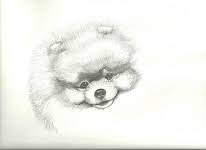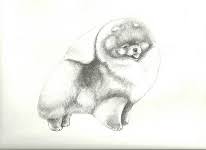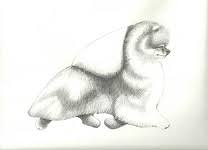
Unfortunately, I have to respect the FCI standard from 1998, when the Pomeranian was unreasonably assigned to the European German Spitz!
In principle, however, I follow the American and Canadian standard of the breed, where the Pomeranian has developed for over 100 years into a different form than that of the European Miniature Spitz and where its standard was elaborated in detail and figuratively and from where I also import breeding dogs and bitches.
Unfortunately, the Pomeranian breed, which has already had its detailed standard for many years, in the country of their development - Great Britain and the USA, was assigned to the standard of the German Spitz breed in 1998.

A brief look back at the origin of the breed of p o m e r a n i a n :
Originally a dog weighing almost 30 kg, it served as a capable shepherd dog and a guardian of sheep (in this larger form). Its original colour was wolf-sable. Sometime in the middle of the 18th century, it stole the heart of Queen Charlotte of England, Princess of Mecklenburg and wife of King George III of England. In the accompanying letter, Lord Haarcourt mentions a pair of "Pomeranian dogs", which he brought as a gift "from Pomerania" and which he gave to the Queen. Their names were Phoebe and Mercury and they became darlings of the court and often posed in portraits together with the royal family. Since then, they have been called Pomeranian.
Until 1870, when the Kennel Club (England) recognized the breed as the so-called Spitz dog, they were not known.
In 1888, Queen Victoria fell in love with an orange Spitz in Florence, Italy and brought it to England. This importation dramatically influenced the popularity of Pomeranians not only in England. Queen Victoria was not only responsible for the sudden popularity of Pomeranians but also for their gradual change of size.
In 1888, the first Pomeranian Dick was brought to the USA and was entered in the studbook of the American Kennel Club. In 1892, as the first representative of the breed, he presented himself at an exhibition in New York. The AKC recognized it already in 1900 and its popularity grew very quickly here. In 1909, the American Pomeranian Club was admitted as a full member of the AKC. In 1938, the Sealand Moneybox Pomeranian was purchased for a whopping $2,500 in England and imported into the US. Until the middle of the century, the Pomeranian was one of the most popular dog breeds in America. In the 1970s, it ranked 14th out of 155 breeds registered by the AKC. And over the years, it has undergone a transformation. The texture and richness of the coat have changed completely, the skeleton has become stronger, the angulations of the front and rear limbs have changed, and thus the related movement of the dog, the character and the proudly carried erect head.
The entire Pomeranian standard according to the CKC standard (front page) by Christine D. Heartz here: https://www.facebook.com/


Visual standard of Pomeranian according to the CKC standard


View of the ideal head and figure, including the motion of the Pomeranian, according to the CKC standard.

Country of development: USA, social breed


Pomeranian

German Miniature Spitz

Nature and characteristics of Pomeranian
The Pomeranian breed is a deliberately bred dog miniature, with a foxy expression. It comes from a family of larger pointy dogs, located in the vicinity of German and Polish territory. On the territory of Great Britain and later the USA, it was bred to become today's charming and elegant companion of humans. It is known around the world for its rich, fluffy coat, short stature and temperament. Pomeranian is a great dog for the owner, especially for its appearance, character and charming ways. It brings elegance and excitement to every family.
It is suitable for families looking for a temperamental dwarf resistant dog that will love you and your friends.
It is a very sociable dog that resembles a toy dog with a baby face or a teddy bear.

Despite its temperament, it is a very intelligent dog that is very distinguished and disciplined in serious situations (exhibitions and visits).
Its most remarkable feature is the desire for human favour. It loves people and is very sociable. Pomeranians tolerate each other very well, so you can also get a few Pomeranians.
2013 - historical article about Pomeranians in the magazine Pes přítel člověka No. 1/2013 - http://www.pomeranian.cz/
Twenty Principles of breeding https://view.officeapps.live.com/
So these are for me the standard/ideal representatives of all sizes and varieties of Spitz, coming from the German territory - Pomerania. However, some of them continued to be bred and developed for decades either in Central Europe or overseas.
